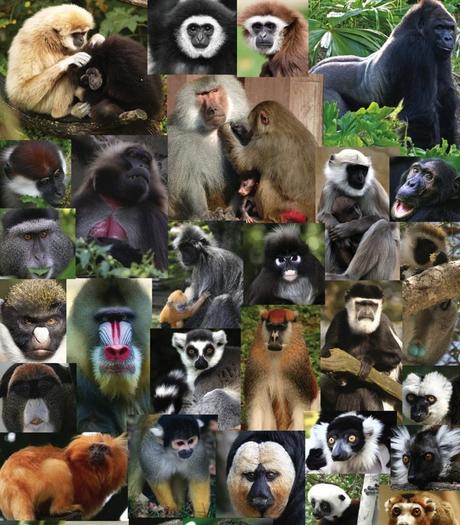In my last Lemur post I talked about the history of Lemurs, this blog will help you understand the differences between lemurs and the primates that we are more familiar with. When you hear the word primate- you probably think of a chimpanzee and the various species of monkey you’ve seen at zoos. Primates also include the great apes- orangutans, gorillas, gibbons, and humans as well as lemurs, lorises, bushbabies, and tarsiers.

Traditionally primates are divided into two groups- Prosimians which include lemurs, lorises, and tarsiers and Anthropoids which include monkeys, apes, and humans.
However more recent classifications divides them this way – the suborder Strepsirhini includes lemurs, lorises, and bush babies and the suborder Haplorhini includes monkeys, apes, and tarsiers. Which is thought to reflect evolutionary history better than the Prosimian vs. Anthropoid. The difference between these two divisions are the tarsiers, which are more closely related to the Anthropoids, though they share certain features with the lemurs and lorises.

Prosimian vs Anthropoid
Ecologically speaking they are slightly different: Anthropoids fill more niches than Prosimians, they are able to live in places which are drier, colder, sparser etc. They are also able to exploit more food sources than Prosimians. And Anthropoids are all diurnal, with one exception.
The National Zoo’s website had this great chart which breaks down the differences between Anthropoids (monkeys and apes) and Prosimians:
| Prosimians | Monkeys | Apes |

|

|

|
If you look at it this way—> Stepsirhini vs Haplorhini
Stepsirhini (lemurs) have a divided upper lip- only attached on the inside, they have a moist naked nose (like a dog), they also have eyes with a reflecting tapetum (which helps them pick up low levels of light), they have smaller brains, lower basal metabolic rates and they rely heavily on smell (olfactory) for communication. Whereas Haplorhini (monkeys and apes) have dry noses surrounded by hair, they have larger brains, higher basal metabolic rates and they rely on sight for communication

Wondering what a tooth comb or a grooming claw is? In my next lemur post I’ll talk about what makes Lemurs unique.
This is awesome! I can always fill up the Meet the Keeper-Lemur talks I do with interesting trivia and natural history about lemurs, but I often skirt around the “what makes them not a monkey?” when it comes up, simply because I’ve never had a super clear way to describe the differences. I think I’ll copy that last bit down and keep it with my other pocket info and business cards for those space cadet moments that always come at the most inopportune times.
Thanks Sarah, I agree that explaining how lemurs differ from other primates is the hardest part. I tried writing it in my own words but the chart just says it all with little confusion so I had to add it. Hope it helps!
Thank you for the wonderfully organized information! I’m taking a primate class for the first time and your intro. was great for better understanding classification.
But don’t bonobos have longer legs than arms? (In reference to the National Zoo’s chart.)
There are exceptions to every rule Alyssa. A good Bonobo reference site is http://library.sandiegozoo.org/factsheets/bonobo/bonobo.htm